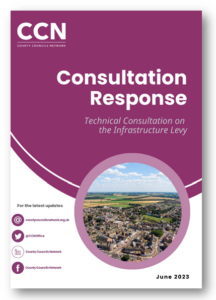
CCN Latest News, CCN News 2023 | 16 June 2023

CCN has joined 29 other signatories in signing a letter to the Housing, Communities and Levelling Up Secretary Michael Gove, calling on him to not implement the proposed Infrastructure Levy, warning it could result in less infrastructure being delivered, fewer affordable homes being built and could impact on housing delivery.
The letter can be read which was organised by the Royal Town Planning Institute, can be read here. It has been covered in today’s The Times.
The Infrastructure Ley will replace the current system of developer contributions, which includes Section 106 payments and the Community Infrastructure (CIL). CCN has long called for reforms to CIL, and this year published a major report on developer contributions which raised concerns over its the implementation of its replacement, the Infrastructure Levy.
 Alongside the joint letter, last week, CCN responded to the government’s technical consultation on implementing the infrastructure levy which can be downloaded here.
Alongside the joint letter, last week, CCN responded to the government’s technical consultation on implementing the infrastructure levy which can be downloaded here.
Concerns raised include:
 Cllr Roger Gough, Housing and Planning Spokesperson for the County Councils Network, said:
Cllr Roger Gough, Housing and Planning Spokesperson for the County Councils Network, said:
“Considering local authorities already experience challenges in delivering sufficient affordable homes and infrastructure needed to mitigate the impacts of development, attempts to reform the present system are laudable.
“But the proposed Infrastructure Levy could end up being the worst of both worlds: resulting in less funding being made available for vital infrastructure, less affordable homes being delivered than before and impacting on the viability of development.
“At a time when it is crucial that we ensure that there is enough infrastructure to ease local pressures and create sustainable communities as well as building as many homes as possible, the upheaval of introducing a new system will create even more uncertainty to a system which is already not firing on all cylinders and instead the government should seek to strengthen the present S106 and CIL mechanisms.”
Cllr Gough was one of the 30 signatories to the letter, which warns that the levy could make it ‘harder, not easier, for local leaders and communities to secure the benefits of new development’ – resulting in councils and housing providers delivering fewer homes for affordable and social rent, while less critical infrastructure could be built in tandem with development such as roads, health centres, and schools.
Despite the government anticipating that the new system will help bring about more affordable housing, the signatories argue that it is unclear how the proposed levy’s rates and thresholds will protect the delivery of affordable homes, warning that ‘we cannot support reforms that are likely to leave communities with fewer new social and affordable homes, mixed and balanced developments and less of the infrastructure they need.’
Councils are concerned that the levy could squeeze the amount of money made available for infrastructure to go alongside development to ease the pressure on existing services and communities.
The signatories warn that, as the government’s own supporting evidence suggests, the levy rates and thresholds would only be practicable on certain sites and would pose a serious threat to housing delivery in many areas. Whilst then model may work on greenfield sites it would make many brownfield sites unviable, perpetuating regional inequalities, creating another barrier to delivery and deepening our already acute housing crisis.
The letter also warns that the time it would take to roll it out and the complexity of the new system would create prolonged uncertainty across the planning system, and instead have called on the government to work with the sector to improve the current system of S106 and CIL payments.
The letter reads:
“Regretfully, many of the difficulties that we’ve experienced using existing Section 106 (S106) and Community Infrastructure Levy (CIL) mechanisms look likely to continue after the new system has been adopted.
It remains unclear how Infrastructure Levy rates and thresholds will sufficiently uphold the economic viability of projects, protect the delivery of affordable homes and homes for social rent and return enough money to fund the infrastructure growing communities need.
….This radical overhaul of the developer contribution system therefore presents significant operational and economic challenges that will make it difficult for existing communities to realise the benefits of new development in their area.”
© 2024 County Councils Network | Credits | Site map | Cookies | Privacy Policy.